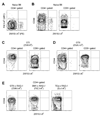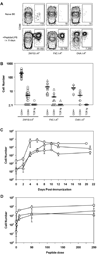Naive CD4(+) T cell frequency varies for different epitopes and predicts repertoire diversity and response magnitude
- PMID: 17707129
- PMCID: PMC2200089
- DOI: 10.1016/j.immuni.2007.07.007
Naive CD4(+) T cell frequency varies for different epitopes and predicts repertoire diversity and response magnitude
Abstract
Cell-mediated immunity stems from the proliferation of naive T lymphocytes expressing T cell antigen receptors (TCRs) specific for foreign peptides bound to host major histocompatibility complex (MHC) molecules. Because of the tremendous diversity of the T cell repertoire, naive T cells specific for any one peptide:MHC complex (pMHC) are extremely rare. Thus, it is not known how many naive T cells of any given pMHC specificity exist in the body or how that number influences the immune response. By using soluble pMHC class II (pMHCII) tetramers and magnetic bead enrichment, we found that three different pMHCII-specific naive CD4(+) T cell populations vary in frequency from 20 to 200 cells per mouse. Moreover, naive population size predicted the size and TCR diversity of the primary CD4(+) T cell response after immunization with relevant peptide. Thus, variation in naive T cell frequencies can explain why some peptides are stronger immunogens than others.
Figures






Comment in
-
The alphabeta T cell repertoire comes into focus.Immunity. 2007 Aug;27(2):179-80. doi: 10.1016/j.immuni.2007.08.005. Immunity. 2007. PMID: 17723209
References
-
- Barnden MJ, Allison J, Heath WR, Carbone FR. Defective TCR expression in transgenic mice constructed using cDNA-based alpha- and beta-chain genes under the control of heterologous regulatory elements. Immunol Cell Biol. 1998;76:34–40. - PubMed
-
- Boursalian TE, Golob J, Soper DM, Cooper CJ, Fink PJ. Continued maturation of thymic emigrants in the periphery. Nat Immunol. 2004;5:418–425. - PubMed
Publication types
MeSH terms
Substances
Grants and funding
LinkOut - more resources
Full Text Sources
Other Literature Sources
Research Materials

